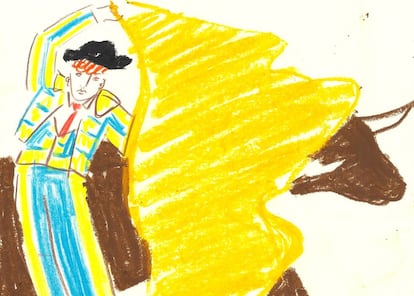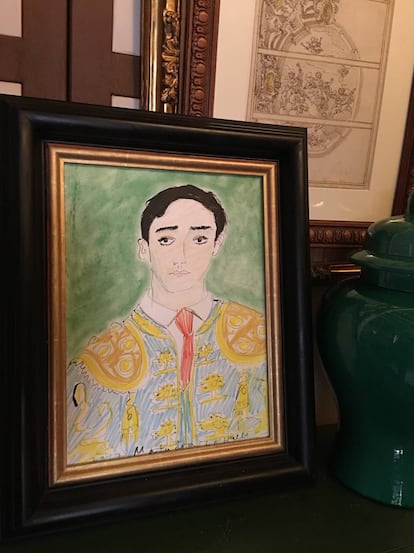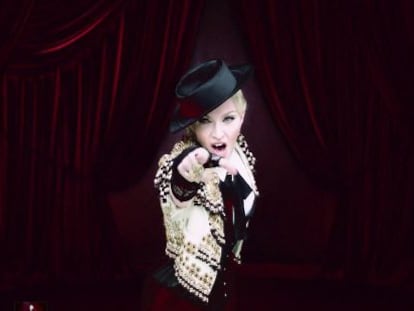Luke Edward Hall: the English artist who draws inspiration from bullfighting
He has never visited Spain or seen a bullfight, yet the designer has managed to attract a legion of fans thanks to his taurine-themed work

Neither the bullfighter’s cropped jacket nor his embroidered pants are garments that would immediately be associated with Luke Edward Hall, a British artist and designer born in 1988, and best known for his drawings of Greek heroes and male beauty from the 1920s and 1930s.
On his Instagram account, Hall posts snaps of weekend jaunts to places such as Belvoir Castle, vacations on the French Riviera or sessions painting watercolors of the English countryside, like a character from a Nancy Mitford novel. But last Halloween, Hall posted a picture of himself donning a traje de luces – traditional bullfighting threads.
From an ethical point of view I don’t know what to make of bullfighting. It’s a complicated issue
Luke Edward Hall
“I was in a shop in London that rents out costumes to the film and theater industry; it has some amazing outfits,” says Hall. “I found one bullfighter’s outfit in red and gold and tried it on and it fit perfectly. It was really fun to wear it for the night.”
Currently a big name on the UK art scene, Hall wore the ensemble to the Halloween party he threw for friends along with his partner, artist Duncan Campbell, at a Bloomsbury Hotel, which is fitting for someone who has turned the figure of the bullfighter into a recurrent theme in his work.

Last year he began selling his art in the famous Liberty designer department store in London. His corner is adorned with a black-and-white drawing of a matador, a cushion featuring a painting of a bull together with books by Cecil Beaton and colored obelisks, and more recognizable Hall pieces such as shirts and Endymion bags, ceramic lamps shaped like Greek columns and cocktail chairs decorated with the busts of Apollo.
“The first piece that I decorated with a bullfighter was a jug,” says Hall. “Since then, I’ve decorated a lot of ceramic pieces with the same motif – trays and bowls. I studied male fashion at university and I am fascinated by the traje de luces.”
The interest Luke Edward Hall has in bullfighting is somewhat superficial as he has never actually been to Spain. “I have never been to a bullfight, although the aesthetics have always fascinated me,” he says. “The bright colors and the detail in the bullfighter’s outfit are beautiful and I love drawing them. But the truth is that from an ethical point of view I don’t know what to make of bullfighting. It’s a complicated issue.”

Hall may never have been to a bullfight, or to Spain, but two of his matador sketches have ended up in Seville. Patricia Medina, a stalwart of society magazines and the niece of model Naty Abascal, is a client and a huge bullfighting fan. Her art collection includes a plate decorated with a painting of a matador taunting a bull and a portrait of a bullfighter, both by Hall. “It’s very odd,” says Medina. “Although he likes the aesthetics of the bullfight, Luke Edward Hall is unfamiliar with the spectacle. Maybe what attracts him is the mythological aspect. Or the Picasso slant.”
Hall agrees that he is passionate about the Spanish painter. “I am a great admirer of Picasso,” he says. “I particularly love his etchings. He captured so much with so few lines! And obviously, I adore his ceramic work, which inspired me when I was beginning with my own pieces.”

Picasso was keen on the bullfight and produced a great many portraits of bullfighters during his career. In 1947, inspired by an exhibition of Madoura ceramics that he had seen the summer before in Vallauris, he started to turn out his own pieces and he decorated many of them with bullfighting scenes. Their optimism and freshness are echoed in Hall’s work. “I love the humor he decorated them with,” says Hall. “The faces and the animals that he drew are very playful.”
Jean Cocteau, another of Hall’s inspirations, was also a great fan of the bullring as well as being a close friend of Picasso, whom he accompanied to many bullfights in Arlés, Nimes and Vallauris. Like Hall, a world of beautiful men populated his murals, sculptures and lithographs with Greek heroes mixing with sailors, poets and bullfighters – among them ‘El Cordobés’ – a famous Spanish bullfighter – who he painted in 1963.
English version by Heather Galloway.
Tu suscripción se está usando en otro dispositivo
¿Quieres añadir otro usuario a tu suscripción?
Si continúas leyendo en este dispositivo, no se podrá leer en el otro.
FlechaTu suscripción se está usando en otro dispositivo y solo puedes acceder a EL PAÍS desde un dispositivo a la vez.
Si quieres compartir tu cuenta, cambia tu suscripción a la modalidad Premium, así podrás añadir otro usuario. Cada uno accederá con su propia cuenta de email, lo que os permitirá personalizar vuestra experiencia en EL PAÍS.
¿Tienes una suscripción de empresa? Accede aquí para contratar más cuentas.
En el caso de no saber quién está usando tu cuenta, te recomendamos cambiar tu contraseña aquí.
Si decides continuar compartiendo tu cuenta, este mensaje se mostrará en tu dispositivo y en el de la otra persona que está usando tu cuenta de forma indefinida, afectando a tu experiencia de lectura. Puedes consultar aquí los términos y condiciones de la suscripción digital.
More information
Archived In
Últimas noticias
Most viewed
- Alain Aspect, Nobel laureate in physics: ‘Einstein was so smart that he would have had to recognize quantum entanglement’
- Mexico’s missing people crisis casts a shadow over World Cup venue
- Why oil has been at the center of Venezuela-US conflicts for decades
- Trump clarifies who is ultimately in charge in Venezuela: ‘Me’
- Mexico seeks to shore up its defenses following US incursion in Venezuela









































